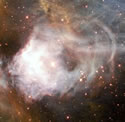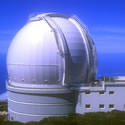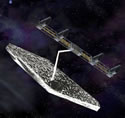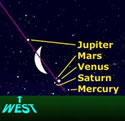Two researchers from Australia believe that life in the Universe may be more common than previously thought. Since life only took half a billion years to gain a foothold on our planet, they theorize, the odds of it happening on any Earth-like world must be good. With only one planet to sample, though, the Earth, there still isn’t any way to judge whether our planet is an anomaly or well within the norm. NASA’s upcoming Terrestrial Planet Finder due for launch in a decade will help scan for Earth-like planets in the future.
Chinese Rocket Launches Two Satellites
A Chinese Long March 4B rocket successfully placed to satellites into orbit on Wednesday: a Fengyun-1D meteorological satellite and a Haiyang-1 marine surveying satellite. Both satellites were developed in China and will help the country’s efforts to monitor its weather. This is the country’s second launch of the year.
Station Oxygen Generator Breaks
Astronauts on board the International Space Station are working to repair a malfunctioning oxygen generator. The primary oxygen has been working off and on over the past few days, so the crew has switched to their backup solid-fuel canisters to keep the atmosphere breathable. NASA doesn’t feel that there’s any urgency to the situation, and hopes to have the problem fixed shortly. Even if they don’t get it working quickly, the space shuttle Endeavour will launch on May 30 with additional oxygen supplies.
Hubble Views Wispy Nebula

Image credit: Hubble
A new photograph taken by the Hubble Space Telescope shows a nebula formed around a group of young, hot, stars. Designated N44C, the nebula is located in the Large Magellanic Cloud, a nearby, small companion galaxy to the Milky Way. It’s peculiar because the star located at the centre of the nebula is inexplicably hot – it could be that the star has a black hole or neutron star companion.
Resembling the hair in Botticelli’s famous portrait of the birth of Venus, softly glowing filaments stream from a complex of hot young stars. This image of a nebula, known as N44C, comes from the archives of NASA’s Hubble Space Telescope (HST). It was taken with the Wide Field Planetary Camera 2 in 1996 and is being presented by the Hubble Heritage Project.
N44C is the designation for a region of glowing hydrogen gas surrounding an association of young stars in the Large Magellanic Cloud, a nearby, small companion galaxy to the Milky Way visible from the Southern Hemisphere.
N44C is peculiar because the star mainly responsible for illuminating the nebula is unusually hot. The most massive stars, ranging from 10-50 times more massive than the Sun, have maximum temperatures of 54,000 to 90,000 degrees Fahrenheit (30,000 to 50,000 degrees Kelvin). The star illuminating N44C appears to be significantly hotter, with a temperature of about 135,000 degrees Fahrenheit (75,000 degrees Kelvin)!
Ideas proposed to explain this unusually high temperature include the possibility of a neutron star or black hole that intermittently produces X-rays but is now “switched off.”
On the top right of this Hubble image is a network of nebulous filaments that inspired comparison to Botticelli. The filaments surround a Wolf-Rayet star, another kind of rare star characterized by an exceptionally vigorous “wind” of charged particles. The shock of the wind colliding with the surrounding gas causes the gas to glow.
N44C is part of the larger N44 complex, which includes young, hot, massive stars, nebulae, and a “superbubble” blown out by multiple supernova explosions. Part of the superbubble is seen in red at the very bottom left of the HST image.
The data were taken in November 1996 with Hubble’s Wide Field Planetary Camera 2 by Donald Garnett (University of Arizona) and collaborators and stored in the Hubble archive. The image was composed by the Hubble Heritage Team (STScI/AURA).
Original Source: Hubble News Release
Buzz Aldrin Working on Mars Shuttle Plans
Although he was the second human to walk on the moon, astronaut Buzz Aldrin isn’t getting out the space race yet. He’s working on plans to develop a massive shuttle that would travel between the Earth and Mars, transferring people and supplies to and from the Red Planet. The shuttle wouldn’t actually stop at Mars, it would just drop off people and then use gravity to make a return voyage back to Earth to pick up more people. And although the idea sounds way off, Aldrin, and researchers from Purdue University believe something could be developed by 2018.
Cannibalistic Stars May Hold Clues to the Big Bang

Image credit: PPARC
A team of UK astronomers have discovered a new class of cannibalistic stars that may explain one of the mysteries surrounding the Big Bang. These stars formed shortly after the Big Bang but don’t contain any lithium -which astronomers predicted should be there. Astronomers believed that they must have misunderstood some essential aspect about the early universe, but this new research helps explain what happened to the lithium; it was destroyed by the star’s interaction with a partner star.
A team of UK astronomers announced this month the discovery of cannibalistic stars that explain one of the mysteries surrounding the Big Bang. The stars are almost as old as the Universe and they reveal what space was like in the very beginning.
The team from the Open University found that a group of 14-billion-year-old stars were all in a spin (literally) because of a nasty phase earlier in their lives. They were, in short, cannibalistic stars. The scientists’ discovery not only explains the origin of these mysterious stars, but also strengthens the Big Bang theory. The Big Bang is the name given to the rapid expansion of the Universe that marked the beginning of space and time; it explains the origin of the matter in the universe – including the matter which people are made of.
The stars under investigation are some of the oldest in the Universe. They formed out of gas clouds not long after the Big Bang. The OU team, led by Dr Sean Ryan, found that some of the stars that formed early in the life of the Universe were very unusual. They contained none of the metal lithium which astronomers believe is produced in the Big Bang.
Dr Ryan said:
“Observations showed that about 1 star in 20 contained no lithium, and some astronomers were concerned that this might mean we had misunderstood something important about the Big Bang and the origin of the Universe.”
New and more detailed observations of the peculiar stars were made with the 4.2-metre-diameter William Herschel Telescope. Using high precision equipment, the team found that most of the stars without lithium were spinning very fast. “Measuring the spin speed of stars is very difficult,” said Dr Ryan, “this is why no-one had seen this before. Most 14-billion-year-old stars do not spin very fast at all but these ones had up to 16 times as much spin energy as the Sun, our nearest star. We knew that the extra energy could come from only one source; another star.”
Dr Ulrich Kolb, an OU astronomer who specialises in interacting stars, explained what happened. “When these stars formed out of the gas clouds, not just one but two stars formed very near one another. Fatally, they were too close together for their own good. As they grew older, the smaller one captured the outer layers of the larger one. Very little now remains of what was the larger star; it has been cannibalised by its companion.”
The material captured by the companion carried orbital energy that was converted into spin energy. It was the discovery of the excessive spin energy that revealed the history of the objects.
The scientists believe that the lithium was destroyed in nuclear reactions shortly before the star-eating episode occurred.
Dr Ryan said:
“It’s rather a relief that we have discovered why the lithium-depleted stars are so different to most others. Knowing that the Big Bang theory tells us correctly how much lithium was produced gives us confidence that we really do understand much about the origin of the entire universe. Hydrogen that was formed in the Big Bang powers the Sun, which in turn provides energy to the Earth. It is also a vital component of pure water, which is so essential to life. Also we now know more about what happens when stars feed on one another.”
Using a technique called Doppler spectroscopy, the observations were made by measuring the speeds at which the stars are moving. This is similar to the way traffic speeds are measured on roads, but with stars clocking up many kilometres per second, not just a few kilometres per hour. The William Herschel Telescope on which the observations were made is one of the UK’s major telescopes. It is co-funded and operated by the Particle Physics and Astronomy Council (PPARC). It is located under the clear skies of the Canary Islands, where observing conditions are much better than in Great Britain. The telescope is shared with Dutch and Spanish astronomers. Dr Sean Ryan will be observing from the Canary Islands on 22-24 May.
Original Source: PPARC News Release
NASA Selects Two Planet Finding Concepts

Image credit: NASA
NASA has selected two new concepts to advance the search for extrasolar planets; one of the technologies will eventually be selected for the Terrestrial Planet Finder mission. The first choice involves the use of an Infrared Interferometer, where multiple spacecraft will simulate a much larger observatory and search for the infrared signature of a planet around a distant star. The other concept is a Visible Light Coronagraph; a telescope 4 times as large and 10 times as powerful as Hubble, capable of imaging distant planets directly. NASA will choose one path in 2005-2006.
As part of its quest to find Earth-sized planets around stars and look for telltale chemical signatures of life, NASA has chosen two mission architecture concepts for further study and technology development.
The two architectures are being explored for the Terrestrial Planet Finder mission. Each would use a different means to achieve the same goal ? to block the light from a parent star in order to see its much smaller, dimmer planets. That technology challenge has been likened to finding a firefly near the beam of a brilliant searchlight from far away. Additional goals of the mission would include characterizing the surfaces and atmospheres of newfound planets, and looking for the chemical signatures of life.
The two candidate architectures are:
— Infrared Interferometer: Multiple small telescopes on a fixed structure or on separated spacecraft flying in precision formation would simulate a much larger, very powerful telescope. The interferometer would utilize a technique called nulling to reduce the starlight by a factor of one million, thus enabling the detection of the very dim infrared emission from the planets.
— Visible Light Coronagraph: A large optical telescope, with a mirror three to four times bigger and at least 10 times more precise than the Hubble Space Telescope, would collect starlight and the very dim reflected light from the planets. The telescope would have special optics to reduce the starlight by a factor of one billion, thus enabling astronomers to detect the faint planets.
The Terrestrial Planet Finder project at NASA?s Jet Propulsion Laboratory, Pasadena, Calif., selected the two candidates based on results from four industrial-academic teams that conducted a 2-1/2 year study of more than 60 possible designs. The two architectures were determined to be sufficiently realistic to warrant further study and technological development in support of a launch of Terrestrial Planet Finder by the middle of the next decade.
NASA and JPL will issue calls for proposals seeking input on the development and demonstration of technologies to implement the two architectures, and on scientific research relevant to planet finding. It is anticipated that one of the two architectures will be selected in 2005 or 2006 to be implemented for the mission, which may include international collaboration.
Terrestrial Planet Finder is part of NASA?s Origins Program, a series of missions to study the formation of galaxies, stars and planets, and to search for life. The program seeks to answers the questions: Where did we come from? Are we alone?
More information on the Terrestrial Planet Finder is available at http://tpf.jpl.nasa.gov/ .
More information on the Origins Program is available at http://origins.jpl.nasa.gov . Additional information on JPL?s planet-finding missions is available at http://planetquest.jpl.nasa.gov/ .
JPL manages the Terrestrial Planet Finder mission and the Origins Program for NASA’s Office of Space Science, Washington, D.C. JPL is a division of the California Institute of Technology in Pasadena.
Original Source: NASA News Release
New Planetary Show on Monday

Image credit: NASA
The moon and five planets will appear close together in the night sky on Monday evening forming a rarely seen planetary conjunction. Look to the West, just after sunset. The planet Venus will be the brightest object in the sky, with Mars and Saturn below, and Jupiter above – Mercury will be visible just above the horizon, much dimmer than the rest. This will be the tightest conjunction of the planets in 40 years.
The Moon will join five visible planets to perform a seldom-seen celestial show on the evening of May 13.
To see the conjunction of the planets and moon, look in the western sky above the horizon just after sunset. Look for Venus, the brightest star in the group. Red Mars will be right below, and Jupiter, which appears white, will be topmost. Mercury is closest to the horizon, and Saturn is just below Mars.
“You’ll see just a sliver of the Moon, because it will be one day past new,” said Dr. E.M. Standish, an astronomer, also of JPL. “This will be the tightest conjunction for almost 40 years.”
A five-planet conjunction isn’t new; astronomers have been recording the phenomenon for over 3,500 years. Dr. Kevin Yau, an astronomer at NASA’s Jet Propulsion Laboratory, Pasadena, Calif., has studied ancient Chinese astronomy texts to find out more about the conjunction.
“The Han Dynasty came to power in 605 BC,” Yau said. “One year later astronomers saw a five-planet conjunction gathered in the constellation Dongjing – what we would call Gemini.” This led to the ancient Chinese belief that the conjunction was an omen of change, but the alignment really has no effect on Earth or Earthlings.
Based upon good observing circumstances, 40 five-planet conjunction events may [vcm2]have been seen between the years 2000 BC and AD 2000. The next time these bodies will be grouped so closely together will be in September 2040.
“This alignment is a great opportunity to see the planets, since they are so easy to find in the sky,” he said.
As part of the imperial establishment in ancient China, an astronomical observatory was usually built inside the capital city of the time. Trained astronomers were appointed to keep a diligent watch of the sky day and night. The Chinese constellations have names that represent palaces and gardens, generals and ministers.
“Today, we are grateful that such detailed observational records were kept,” Yau said. “Our modern astronomical database goes back about five hundred years, which is relatively short in terms of astronomical timescales.” Astronomers often need to access data covering a longer time span in order to prove or disprove their theories such as the effect of the 11-year solar cycle on the Earth’s climate change, or predictions of when a comet will be visible from Earth.
JPL is managed for NASA by the California Institute of Technology in Pasadena.
Original Source: NASA/JPL News Release
Baikonur Cosmodrome Roof Collapses
The roof of an 80-metre hanger at the Baikonur cosmodrome in Kazakhstan collapsed on Sunday trapping eight workers under the debris. Russian officials believe it’s unlikely any of the workers survived the fall, and have prevented anyone from approaching the hanger for fear the unsteady walls could cave in as well. The collapsed hanger was built in the late 60s for the Soviet space program, and was later used to house a Buran space shuttle.
Does Whatever a Spider Can
My wife and I went to see Spider-Man on Sunday, and so I thought I’d celebrate with a Hubble image of the Tarantula nebula (trust me, when you’ve got a six-month old, you celebrate the chance to see a movie).
To make this your computer screen’s background, click the image that matches your screen’s resolution, right-click “Set as Background”.
1024×768 (168K) – 800×600 (110K) – 640×480 (77K)
On a completely unrelated note, lots of you have a computer virus. I know this because I’m probably receiving hundreds of viruses a day from various readers. I can’t inform you individually because the virus disguises who actually sent it. Here’s a free virus scanner that I like.
Fraser Cain
Publisher, Universe Today
